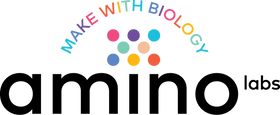|
|
|
Chapter 1 - Isolating DNA, the Blueprints of Life:
- extract and see real genomic DNA from strawberries using the DNA extraction kit,
- assemble a DNA structure utilizing a drag and drop simulator,
- discover 'What is DNA?', 'What is DNA's function?', and 'What is DNA made of?',
- learn about the history of DNA, its evolution, the road to precisely editing DNA and its future,
- understand how DNA can be used in biotechnology to create products,
- understand how atoms, molecules, macromolecules (nucleic acid), and nucleotides come into play.
|
|
Chapter 2 - Safety & setting up your Genetic Engineering Hero Space
- learn about the 4 Biosafety levels & how to stay safe & responsible during your biotechnology science projects,
- discover the rules & regulations in biotechnology,
- set up your own lab - What type of laboratory equipment is necessary? What kind of locations can be used for a safe & responsible biotechnology lab,
- learn how to inactivate your biotechnology science experiments and clean up your laboratory,
- download a laboratory safety checklist, a biosafety poster, and a biosecurity poster,
- understand the ethics, lab safety & best practices surrounding genetic engineering and biotechnology.
|
|
Chapter 3 - Growing E. coli cells
- grow colorful, friendly lab-strain of bacteria and use it to make bioart in a virtual simulator and then in real-life using the Canvas kit (optional hands-on),
- learn the difference between safe laboratory E. coli vs. ‘bad’ E. coli and its history,
- learn 'What is a cell?'
- tour the cell structure using the Cells as (micro) factories analogy - a comparison between factories and cells.
- discover the role of macromolecules: carbs, lipids, proteins
|
|
Chapter 4 - Genetic Engineering your E. coli cells
- engineer bacteria (cells) with a pre-made DNA program in a virtual simulator and then in real-life using the Engineer-it kit (optional hands-on),
- learn the primary operating environment of a cell,
- start understanding how cells read DNA: How do cells know how to start, do and stop reading DNA (transcription),
- discover 'What is a gene?'
- find out what DNA plasmids are and how to use them in biotechnology.
|
|
Chapter 5 - Extracting your engineered proteins
- extract the proteins created by your engineer bacteria in real-life using the Extract-it kit so that they can be used in the 'real-world' (optional hands-on),
- continue understanding how cells know how to start, do and stop reading RNA (translation),
- discover proteins & enzymes, promoters vs. the ribosomal binding site and the other RNAs (rRNA & tRNA),
- learn and use the RNA to protein cipher.
|
|
Chapter 6 - Processing Chemicals with Enzymes
- engineer cells to created small molecules and enzymes to create products like smells and color-changing molecules using the Smell-it kit and the Blue-it kit (optional hands-on),
- learn the basics of enzymatic chemical reactions,
- understand the Four B’s of cell function in action,
- discover protein enzymes as catalysis in cells,
- learn the basic structure of atoms and the four major types of bonds,
- explorer metabolic pathways and how they are used in genetic engineering and biotechnology.
|
|
Chapter 7 - Manually turning on genes in situ
- engineer cells or use pre-engineered cells and manually turn on genes using light, chemicals, and heat to understand genetic switched in real-life using the RGB kit, the Induce-it kit and the Heat-it kit (optional hands-on),
- learn the mechanisms of gene expression,
- revise and apply the coding and non-coding regions of genes knowledge from Ch. 4-5,
- explore a DNA plasmid map,
- start setting the stage for you to design your custom DNA plasmids.
|

